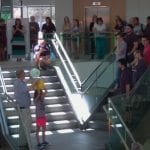Wooster Hall at SUNY New Paltz has a neat feature. The main staircase is exactly aligned along a north-south line, and skylight windows in the ceiling were placed so that light from those windows lines up at the bottom of the staircase at solar noon on the equinoxes. In the summer the sun is […]
Summer Solstice in Wooster Hall
